Question
Five pipes labelled, “6 metres in length”, were delivered to a building site. The contractor measured each pipe to check its length (in metres) and recorded the following;
5.96, 5.95, 6.02, 5.95, 5.99.
(i) Find the mean of the contractor’s measurements.
(ii) Calculate the percentage error between the mean and the stated, approximate length of 6 metres.[3]
Calculate \(\sqrt {{{3.87}^5} – {{8.73}^{ – 0.5}}} \), giving your answer
(i) correct to the nearest integer,
(ii) in the form \(a \times 10^k\), where 1 ≤ a < 10, \(k \in {\mathbb{Z}}\) .[3]
Answer/Explanation
Markscheme
(i) Mean = (5.96 + 5.95 + 6.02 + 5.95 + 5.99) / 5 = 5.974 (5.97) (A1)
(ii) \({\text{% error}} = \frac{{error}}{{actualvalue}} \times 100\% \)
\( = \frac{{6 – 5.974}}{{5.974}} \times 100\% = 0.435\% \) (M1)(A1)(ft)
(M1) for correctly substituted formula.
Allow 0.503% as follow through from 5.97
Note: An answer of 0.433% is incorrect. (C3)[3 marks]
number is 29.45728613
(i) Nearest integer = 29 (A1)
(ii) Standard form = 2.95 × 101 (accept 2.9 × 101) (A1)(ft)(A1)
Award (A1) for each correct term
Award (A1)(A0) for 2.95 × 10 (C3)[3 marks]
Question
State which of the following sets of data are discrete.
(i) Speeds of cars travelling along a road.
(ii) Numbers of members in families.
(iii) Maximum daily temperatures.
(iv) Heights of people in a class measured to the nearest cm.
(v) Daily intake of protein by members of a sporting team.[2]
The boxplot below shows the statistics for a set of data.
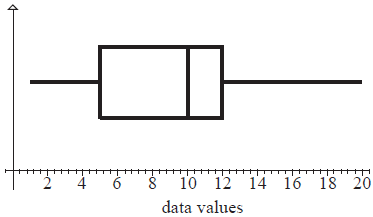
For this data set write down the value of
(i) the median
(ii) the upper quartile
(iii) the minimum value present[3]
Write down three different integers whose mean is 10.[1]
Answer/Explanation
Markscheme
(ii) and (iv) are discrete. (A1)(A1)
Award (A1)(A0) for both correct and one incorrect.
Award (A1)(A0) for one correct and two incorrect.
Otherwise, (A0)(A0). (C2)[2 marks]
(i) Median = 10 (A1)
(ii) Q3 = 12 (A1)
(iii) Min value = 1 (±0.2) (A1) (C3)[3 marks]
Any three different integers whose mean is 10 e.g. 9, 10, 11. (A1) (C1)[1 mark]
Question
Write down the following numbers in increasing order.
\(3.5\), \(1.6 \times 10^{−19}\), \(60730\), \(6.073 \times 10^{5}\), \(0.006073 \times 10^6\), \(\pi\), \(9.8 \times 10^{−18}\).[3]
Write down the median of the numbers in part (a).[1]
State which of the numbers in part (a) is irrational.[1]
Answer/Explanation
Markscheme
\(1.6 \times 10^{−19}\), \(9.8 \times 10^{−18}\), \(\pi\), \(3.5\), \(0.006073 \times 10^6\), \(60730\), \(6.073 \times 10^{5}\) (A4)
Award (A1) for \(\pi\) before 3.5
Award (A1) for \(1.6 \times 10^{−19}\) before \(9.8 \times 10^{−18}\)
Award (A1) for the three numbers containing 6073 in the correct order.
Award (A1) for the pair with negative indices placed before 3.5 and \(\pi\) and the remaining three numbers placed after (independently of the other three marks).
Award (A3) for numbers given in correct decreasing order.
Award (A2) for decreasing order with at most 1 error (C4)[3 marks]
The median is 3.5. (A1)(ft)
Follow through from candidate’s list. (C1)[1 mark]
\(\pi\) is irrational. (A1) (C1)[1 mark]
Question
There are \(120\) teachers in a school. Their ages are represented by the cumulative frequency graph below.
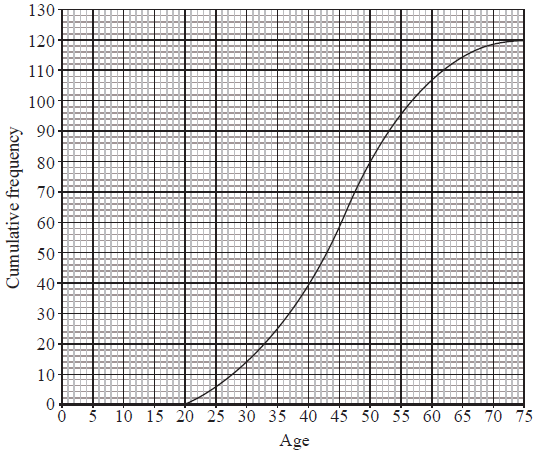
Write down the median age.[1]
Find the interquartile range for the ages.[2]
Given that the youngest teacher is \(21\) years old and the oldest is \(72\) years old, represent the information on a box and whisker plot using the scale below.
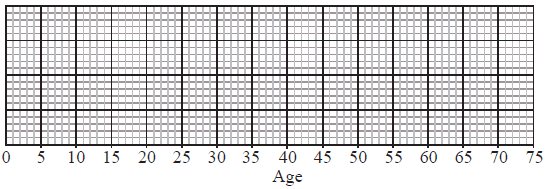 [3]
[3]
Answer/Explanation
Markscheme
\({\text{Median }}= 45\) (A1) (C1)
Accept \(45.5\)[1 mark]
\(53 – 37\) for identifying correct quartiles (A1)
\( = 16\) for correct answer to subtraction (A1)(ft) (C2)
(ft) on their quartiles[2 marks]
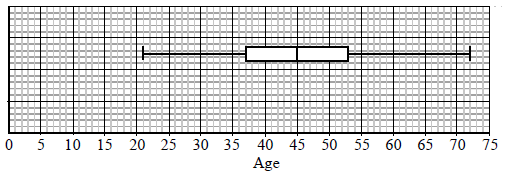
Median marked correctly. (A1)(ft)
Box with ends at candidate’s quartiles. (A1)(ft)
End points at \(21\) and \(72\) joined to box with straight lines. (A1) (C3)
Note: Award (A0) if lines go right through the box.[3 marks]
Question
Complete the following table of values for the height and weight of seven students.

Answer/Explanation
Markscheme
\({\text{Mode}} = 171\) (A1)
\({\text{Median }}148{\text{, }}151{\text{, }}158{\text{, }}163{\text{, }}171{\text{, }}171{\text{, }}184\)
\( = 163\) (A1)
\({\text{Mean}} = 64.7\) (A1)
\({\text{Standard deviation}} = 13.3\) (A1) (C4)
Note: If both mean and standard deviation given to 2 significant figures
\({\text{Mean }}65\), (A0)(AP)
\({\text{Standard deviation }}13\) (A1)(ft) ((AP) already deducted).[4 marks]
Question
A survey was conducted of the number of bedrooms in \(208\) randomly chosen houses. The results are shown in the following table.

State whether the data is discrete or continuous.[1]
Write down the mean number of bedrooms per house.[2]
Write down the standard deviation of the number of bedrooms per house.[1]
Find how many houses have a number of bedrooms greater than one standard deviation above the mean.[2]
Answer/Explanation
Markscheme
Discrete (A1) (C1)[1 mark]
For attempting to find \(\sum fx/\sum f\) (M1)
\(2.73\) (A1) (C2)
Note: for (b) and (c), if both mean and standard deviation given to 2 significant figures.
Award (C1)(C0)(AP) for \(2.7\). Award (A1)(ft) for \(1.3\) ((AP) already deducted).[2 marks]
\(1.34\) (A1) (C1)
Note: for (b) and (c), if both mean and standard deviation given to 2 significant figures.
Award (C1)(C0)(AP) for \(2.7\). Award (A1)(ft) for \(1.3\) ((AP) already deducted).[1 mark]
Attempt to find their mean \( + \) their standard deviation (can be implied) (M1)
\(23\), (ft) their mean and standard deviation. (A1)(ft) (C2)[2 marks]
Question
The grades obtained by a group of \(20\) IB students are listed below:

Complete the following table for the grades obtained by the students.
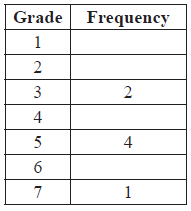 [2]
[2]
Write down the modal grade obtained by the students.[1]
Calculate the median grade obtained by the students.[2]
One student is chosen at random from the group.
Find the probability that this student obtained either grade \(4\) or grade \(5\).[1]
Answer/Explanation
Markscheme
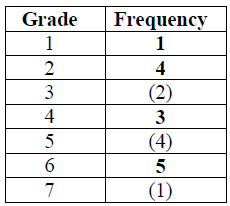 (A2) (C2)
(A2) (C2)
Notes: Award (A1) for three correct. Award (A0) for two or fewer correct.[2 marks]
\({\text{Mode}} = 6\) (A1)(ft) (C1)[1 mark]
\({\text{Median}} = 4.5\) (M1)(A1)(ft) (C2)
Note: (M1) for attempt to order raw data (if frequency table not used) or (M1) halfway between 10th and 11th result.[2 marks]
\(\frac{7}{{20}}{\text{ }}(0.35{\text{, }}35\% )\) (A1)(ft) (C1)[1 mark]
Question
The following table shows the number of errors per page in a 100 page document.

State whether the data is discrete, continuous or neither.[1]
Find the mean number of errors per page.[2]
Find the median number of errors per page.[2]
Write down the mode.[1]
Answer/Explanation
Markscheme
Discrete (A1) (C1)[1 mark]
\(\frac{{0 + 24 + 40 + 51 + 44}}{{100}} = \frac{{159}}{{100}} = 1.59\) (M1)(A1) (C2)
Notes: Award (M1) for correctly substituted formula.
Award (M1)(A1) for 1 or 2 if 1.59 is seen.
Award (M0)(A0) for 1 or 2 seen with no working.[2 marks]
1 (M1)(A1) (C2)
Note: Award (M1) for attempt to order raw data (if frequency table not used) or (M1) for indicating halfway between 50th and 51st result or (M1) for 50th percentile seen.[2 marks]
0 (A1) (C1)[1 mark]
Question
The temperatures in °C, at midday in Geneva, were measured for eight days and the results are recorded below.
7, 4, 5, 4, 8, T, 14, 4
The mean temperature was found to be 7 °C.
Find the value of T.[3]
Write down the mode.[1]
Find the median.[2]
Answer/Explanation
Markscheme
\(\frac{{7 + 4 + 5 + 4 + 8 + T + 14 + 4}}{8} = 7\) (A1)(A1)
Note: Award (A1) for sum + T, (A1) for 56 or 7 × 8 or 8 in the denominator and 7 seen.
T = 10 (A1) (C3)[3 marks]
4 (A1) (C1)[1 mark]
4, 4, 4, 5, 7, 8, 10, 14 (M1)
Note: Award (M1) for arranging their numbers in order.
Median = 6 (A1)(ft) (C2)[2 marks]
Question
The mean of the ten numbers listed below is 6.8.
8, 5, 5, 10, 8, 4, 9, 7, p, q
Write down an equation in terms of p and q.[2]
The mode of these ten numbers is five and p is less than q.
Write down the value of p.[1]
The mode of these ten numbers is five and p is less than q.
Write down the value of q.[1]
Find the median of the ten numbers.[2]
Answer/Explanation
Markscheme
\(\frac{{8 + 5 + 5 + 10 + 8 + 4 + 9 + 7 + p + q}}{{10}} = 6.8\) or equivalent (M1)(A1) (C2)
Note: Award (M1) for correct substituted mean formula, (A1) for correct substitution.[2 marks]
p = 5 (A1)(ft)[1 mark]
q = 7 (A1)(ft) (C2)
Note: Follow through from their answers to parts (a) and (b) (i).[1 mark]
7 (M1)(A1)(ft) (C2)
Notes: Award (M1) for an attempt to order their numbers.
Follow through from their answers to parts (b)(i) and (ii).[2 marks]
Question
56 students were given a test out of 40 marks. The teacher used the following box and whisker plot to represent the marks of the students.
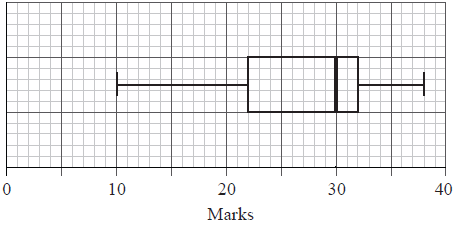
Write down the median mark.[1]
Write down the 75th percentile mark.[1]
Write down the range of marks.[2]
Estimate the number of students who achieved a mark greater than 32.[2]
Answer/Explanation
Markscheme
30 (A1) (C1)[1 mark]
32 (A1) (C1)[1 mark]
38 – 10 = 28 (A1)(A1) (C2)
Note: Award (A1) for 10 and 38 seen, (A1) for correct answer only.[2 marks]
0.25 × 56 = 14 (M1)(A1) (C2)
Note: Award (M1) for multiplying 0.25 by 56.[2 marks]
Question
The table below shows the frequency distribution of the number of dental fillings for a group of \(25\) children.

Find the value of \(q\) .[2]
Use your graphic display calculator to find
(i) the mean number of fillings;
(ii) the median number of fillings;
(iii) the standard deviation of the number of fillings.[4]
Answer/Explanation
Markscheme
\(q = 25 – (4 + 3 + 8 + 4 +1)\) (M1)
Note: Award (M1) for subtraction from \(25\) of all values from the table.
\( = 5\) (A1) (C2)[2 marks]
(i) \(2.2\) (A2)(ft) (C2)
Note: Award (M1) for use of mean formula with correct substitution. Follow through from part (a), irrespective of whether working is shown.
(ii) \(2\) (A1) (C1)
(iii) \(1.39\) (A1)(ft) (C1)
Note: Follow through from part (a), irrespective of whether working is shown. Award (A1) for \(1.38\).[4 marks]
Question
\(80\) matches were played in a football tournament. The following table shows the number of goals scored in all matches.

Find the mean number of goals scored per match.[2]
Find the median number of goals scored per match.[2]
A local newspaper claims that the mean number of goals scored per match is two. Calculate the percentage error in the local newspaper’s claim.[2]
Answer/Explanation
Markscheme
\(\frac{{0 \times 16 + 1 \times 22 + 2 \times 19 \ldots }}{{80}}\) (M1)
Note: Award (M1) for substituting correct values into mean formula.
1.75 (A1) (C2)[2 marks]
An attempt to enumerate the number of goals scored. (M1)
\(2\) (A1) (C2)[2 marks]
\(\frac{{2 – 1.75}}{{1.75}} \times 100\) (M1)
\(14.3 \% \) (A1)(ft) (C2)
Notes: Award (M1) for correctly substituted \(\% \) error formula. \(\% \) sign not required. Follow through from their answer to part (a). If \(100\) is missing and answer incorrect award (M0)(A0). If \(100\) is missing and answer incorrectly rounded award (M1)(A1)(ft)(AP).[2 marks]
Question
The grades obtained by a group of 13 students are listed below. \[5{\text{ }}3{\text{ }}6{\text{ }}5{\text{ }}7{\text{ }}3{\text{ }}2{\text{ }}6{\text{ }}4{\text{ }}6{\text{ }}6{\text{ }}6{\text{ }}4\]
Write down the modal grade.[1]
Find the mean grade.[2]
Write down the standard deviation.[1]
Find the interquartile range.[2]
Answer/Explanation
Markscheme
\(6\) (A1) (C1)[1 mark]
\(\frac{{5 + 3 + 6 + \ldots + 4}}{{13}}\) (M1)
Note: Award (M1)for correctly substituted mean formula, division by 13 must be seen.
\( = 4.85\left( {\frac{{63}}{{13}}} \right)\) \({\text{(4}}{\text{.84615}} \ldots {\text{)}}\) (A1) (C2)[2 marks]
\({\text{1}}{\text{.46}}\) \({\text{(1}}{\text{.4595}} \ldots )\) (A1) (C1)[1 mark]
\(6 – 3.5\) (M1)
\( = 2.5\) (A1) (C2)
Note: Award (M1) for their quartiles seen or a correct ordered list. Accept a correct ordered list from any previous part of the question.[2 marks]
Question
The following six integers are arranged from smallest to largest
1 , x , 3 , y , 14 , z
The mode is 1 , the median is 5 and the mean is 7.
Find x ;[1]
Find y ;[2]
Find z .[3]
Answer/Explanation
Markscheme
x = 1 (A1) (C1)[1 mark]
\(\frac{{3 + y}}{2} = 5\) (M1)
Note: Award (M1) for setting the correct equation or equivalent.
y = 7 (A1) (C2)[2 marks]
1 + 1 + 3 + 7 + 14 + z = 6 × 7 (M1)(M1)
Note: Award (M1) for the sum of their 5 numbers and z, and (M1) for 6 × 7.
z = 16 (A1)(ft) (C3)
Note: Follow through from their x and y found in part (b) provided y is a positive integer less than 14.[3 marks]
Question
The daily rainfall for the town of St. Anna is collected over a 20-day period of time. The collected data are represented in the box and whisker plot below.
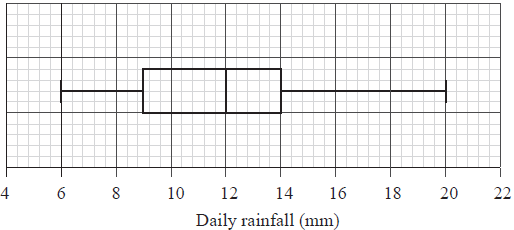
Write down
(i) the lowest daily rainfall;
(ii) the highest daily rainfall.[2]
State what the value of 12 mm represents on the given diagram.[1]
Find the interquartile range.[2]
Write down the percentage of the data which is less than the upper quartile.[1]
Answer/Explanation
Markscheme
(i) 6 (mm) (A1)
(ii) 20 (mm) (A1) (C2)[2 marks]
Median (A1) (C1)
Note: Award (A1) for Q2 or 50th percentile.[1 mark]
14 – 9 (A1)
Note: Award (A1) for 9 and 14 seen.
5 (mm) (A1) (C2)[2 marks]
75 (%) (A1) (C1)[1 mark]
Question
The resting pulse rates of a group of 10 students who exercise regularly are given below.
65, 62, 75, 63, 69, 58, 65, 67, 55, 60
Find the median resting pulse rate of the students.[2]
Find the mean resting pulse rate of the students.[2]
A new student joins the class and the mean resting pulse rate of the group of 11 students becomes 65.
Find the resting pulse rate of the student who joined the group.[2]
Answer/Explanation
Markscheme
Attempt to order set of numbers (M1)
64 (A1) (C2)[2 marks]
\(\frac{639}{10}\) (M1)
Note: Award (M1) for their sum divided by 10.
63.9 (A1) (C2)[2 marks]
\(\frac{{(639 + x)}}{{11}} = 65\) or equivalent (M1)
\(x = 76\) (A1)(ft) (C2)
Notes: Award (M1) for setting up an equation (their part (b) \(\times 10 + x )/11 = 65\). Follow through from their sum seen in part (b). Accept correct alternative methods but not trial and error.[2 marks]
Question
The length, in cm, of six baseball bats was measured. The lengths are given below.
104.5, 105.1, 104.8, 105.2, 104.9, 104.9
Calculate the exact value of the mean length.[2]
Write your answer to part (a) in the form a × 10k where 1 ≤ a < 10 and \(k \in \mathbb{Z}\).[2]
Marian calculates the mean length and finds it to be 105 cm.
Calculate the percentage error made by Marian.[2]
Answer/Explanation
Markscheme
\(\left( {\frac{{104.5 + 105.1 + …}}{6}} \right)\) (M1)
Note: Award (M1) for use of mean formula.
= 104.9 (cm) (A1) (C2)[2 marks]
1.049 × 102 (A1)(ft)(A1)(ft) (C2)
Notes: Award (A1)(ft) for 1.049, (A1)(ft) for 102. Follow through from their part (a).[2 marks]
\(\frac{{105 – 104.9}}{{104.9}} \times 100\) (%) (M1)
Notes: Award (M1) for their correctly substituted % error formula.
% error = 0.0953 (%) (0.0953288…) (A1)(ft) (C2)
Notes: A 2sf answer of 0.095 following \(\frac{{105 – 104.9}}{{105}} \times 100\) working is awarded no marks. Follow through from their part (a), provided it is not 105. Do not accept a negative answer. % sign not required.[2 marks]
Question
The number of passengers in the first ten carriages of a train is listed below.
6 , 8 , 6 , 3 , 8 , 4 , 8 , 5 , p , p
The mean number of passengers per carriage is 5.6.
Calculate the value of p.[2]
Find the median number of passengers per carriage.[2]
If the passengers in the eleventh carriage are also included, the mean number of passengers per carriage increases to 6.0.
Determine the number of passengers in the eleventh carriage of the train.[2]
Answer/Explanation
Markscheme
\(\frac{{48 + 2p}}{{10}} = 5.6\) (M1)
Notes: Accept equivalent forms. Award (M1) for correct substitutions in mean formula.
4 (A1) (C2)
Correctly rearranging the list with their p (M1)
5.5 (A1)(ft) (C2)
Note: Follow through from their value of p in part (a).
\(\frac{{56 + x}}{{11}} = 6.0\) (M1)
Notes: Accept equivalent forms. Award (M1) for correct substitutions in mean formula.
OR
\(\frac{{48 + 2 \times {\text{ their part (a)}} + x}}{{11}}\) (M1)
10 (A1)(ft) (C2)
Note: Follow through from their answer to part (a).
Question
A survey was carried out on a road to determine the number of passengers in each car (excluding the driver). The table shows the results of the survey.

State whether the data is discrete or continuous.[1]
Write down the mode.[1]
Use your graphic display calculator to find
(i) the mean number of passengers per car;
(ii) the median number of passengers per car;
(iii) the standard deviation.[4]
Answer/Explanation
Markscheme
discrete (A1) (C1)[1 mark]
(i) \(1.47\) \((1.46666…)\) (A2)
Note: Award (M1) for \(\frac{{176}}{{120}}\) seen.
Accept \(1\) or \(2\) as a final answer if \(1.4666…\) or \(1.47\) seen.
(ii) \(1.5\) (A1)
(iii) \(1.25\) \((1.25122…)\) (A1) (C4)[4 marks]
Question
A class of 13 Mathematics students received the following grades in their final IB examination.
3 5 3 4 7 3 2 7 5 6 5 3 4
For these grades, find the mode;[1]
For these grades, find the median;[2]
For these grades, find the upper quartile;[1]
For these grades, find the interquartile range.[2]
Answer/Explanation
Markscheme
3 (A1) (C1)[1 mark]
4 (M1)(A1) (C2)
Note: Award (M1) for ordered list of numbers seen.[2 marks]
5.5 (A1) (C1)[1 mark]
5.5 – 3 (M1)
Note: Award (M1) for 3 and their 5.5 seen.
= 2.5 (A1)(ft) (C2)
Note: Follow through from their answer to part (c).[2 marks]
Question
The distribution of rainfall in a town over 80 days is displayed on the following box-and-whisker diagram.
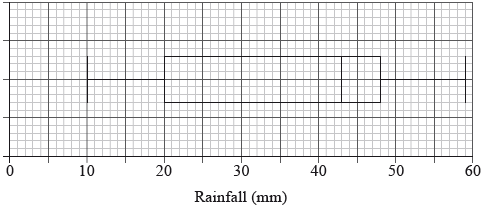
Write down the median rainfall.[1]
Write down the minimum rainfall.[1]
Find the interquartile range.[2]
Write down the number of days the rainfall will be
(i) between 43 mm and 48 mm;
(ii) between 20 mm and 59 mm.[2]
Answer/Explanation
Markscheme
\(43 {\text{ (mm)}}\) (A1) (C1)[1 mark]
\(10{\text{ (mm)}}\) (A1) (C1)[1 mark]
\(48 – 20\) (A1)
\( = 28\) (A1) (C2)
Note: Award (A1) for identifying correct quartiles, (A1) for correct subtraction of the quartiles.[2 marks]
(i) 20 (days) (A1)
(ii) 60 (days) (A1) (C2)[2 marks]
Question
The time, in minutes, that students in a school spend on their homework per day is presented in the following box-and-whisker diagram.

Time, in minutes, students spend on their homework per day
Find
(i) the longest amount of time spent on homework per day;
(ii) the interquartile range.[3]
State the statistical term corresponding to the value of 140 minutes.[1]
Find the percentage of students who spend
(i) between 100 and 140 minutes per day on their homework;
(ii) more than 100 minutes per day on their homework.[2]
Answer/Explanation
Markscheme
(i) 300 (minutes) OR 5 hours (A1)
Note: If answer given in hours, the unit must be seen.
(ii) 220 – 100 (M1)
Notes: Award (M1) for the two quartiles seen.
= 120 (minutes) OR 2 hours (A1) (C3)
Note: If answer given in hours, the unit must be seen.
median (time spent on homework per day) (A1) (C1)
Note: Do not accept middle or medium etc.
(i) 25 (A1)
(ii) 75 (A1) (C2)
Question
In a particular week, the number of eggs laid by each hen on a farm was counted. The results are summarized in the following table.

State whether these data are discrete or continuous.[1]
Write down
(i) the number of hens on the farm;
(ii) the modal number of eggs laid.[2]
Calculate
(i) the mean number of eggs laid;
(ii) the standard deviation.[3]
Answer/Explanation
Markscheme
discrete (A1) (C1)
(i) 60 (A1)
(ii) 5 (A1) (C2)
(i) \(\frac{{1 \times 4 + 2 \times 7 + 3 \times 12 \ldots }}{{60}}\) (M1)
Notes: Award (M1) for an attempt to substitute into the “mean of a set of data” formula, with at least three correct terms in the numerator.
Denominator must be 60.
Follow through from part (b)(i), only if work is seen.
\( = 4.03{\text{ }}(4.03333 \ldots )\) (A1)
Notes: Award at most (M1)(A0) for an answer of 4 but only if working seen.
(ii) \(1.54{\text{ }}(1.53803 \ldots )\) (A1) (C3)
Question
The IB grades attained by a group of students are listed as follows.
\[{\text{6}}\;\;\;{\text{4}}\;\;\;{\text{5}}\;\;\;{\text{3}}\;\;\;{\text{7}}\;\;\;{\text{3}}\;\;\;{\text{5}}\;\;\;{\text{4}}\;\;\;{\text{2}}\;\;\;{\text{5}}\]
Find the median grade.[2]
Calculate the interquartile range.[2]
Find the probability that a student chosen at random from the group scored at least a grade \(4\).[2]
Answer/Explanation
Markscheme
\(2\;\;\;3\;\;\;3\;\;\;4\;\;\;4\;\;\;5\;\;\;5\;\;\;5\;\;\;6\;\;\;7\) (M1)
Note: Award (M1) for correct ordered set.
\(({\text{Median}} = ){\text{ }}4.5\) (A1) (C2)
\(5 – 3\) (M1)
Note: Award (M1) for correct quartiles seen.
\( = 2\) (A1) (C2)
\(\frac{7}{{10}}\;\;\;(0.7,{\text{ }}70\% )\) (A2) (C2)
Question
Two groups of 40 students were asked how many books they have read in the last two months. The results for the first group are shown in the following table.
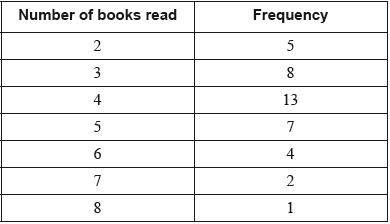
The quartiles for these results are 3 and 5.
Write down the value of the median for these results.[1]
Draw a box-and-whisker diagram for these results on the following grid.
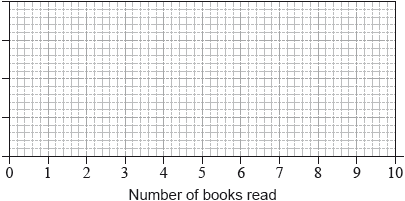 [3]
[3]
The results for the second group of 40 students are shown in the following box-and-whisker diagram.
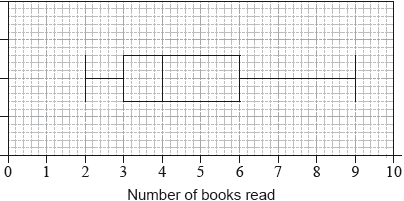
Estimate the number of students in the second group who have read at least 6 books.[2]
Answer/Explanation
Markscheme
\(4\) (A1)(C1)
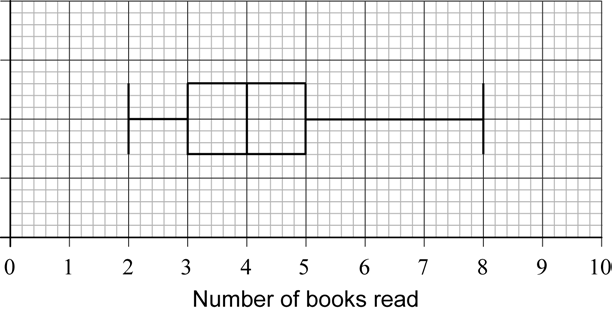 (A1)(ft)(A1)(A1) (C3)
(A1)(ft)(A1)(A1) (C3)
Notes: Award (A1)(ft) for correct median, (A1) for correct quartiles and box, (A1) for endpoints 2 and 8 joined by a straight line that does not cross the box. Follow through from their median from part (a).
\(40 \times 0.25\) (M1)
Notes: Award (M1) for \(40 \times 25\% \;\;\;\)OR\(\;\;\;40 – 40 \times 75\% \).
\(10\) (A1) (C2)
Question
A tetrahedral (four-sided) die has written on it the numbers 1, 2, 3 and 4. The die is rolled many times and the scores are noted. The table below shows the resulting frequency distribution.

The die was rolled a total of 100 times.
The mean score is 2.71.
Write down an equation, in terms of \(x\) and \(y\), for the total number of times the die was rolled.[1]
Using the mean score, write down a second equation in terms of \(x\) and \(y\).[2]
Find the value of \(x\) and of \(y\).[3]
Answer/Explanation
Markscheme
\(18 + x + y + 22 = 100\) or equivalent (A1) (C1)[1 mark]
\(\frac{{18 + 2x + 3y + 88}}{{100}} = 2.71\) or equivalent (M1)(A1) (C2)
Note: Award (M1) for a sum including \(x\) and \(y\), divided by 100 and equated to 2.71, (A1) for a correct equation.[2 marks]
\(x + y = 60\) and \(2x + 3y = 165\) (M1)
Note: Award (M1) for obtaining a correct linear equation in one variable from their (a) and their (b).
This may be implied if seen in part (a) or part (b).
\(x = 15;{\text{ }}y = 45\) (A1)(ft)(A1)(ft) (C3)
Notes: Follow through from parts (a) and (b), irrespective of working seen provided the answers are positive integers.[3 marks]
Question
The histogram shows the time, t, in minutes, that it takes the customers of a restaurant to eat their lunch on one particular day. Each customer took less than 25 minutes.
The histogram is incomplete, and only shows data for 0 ≤ t < 20.
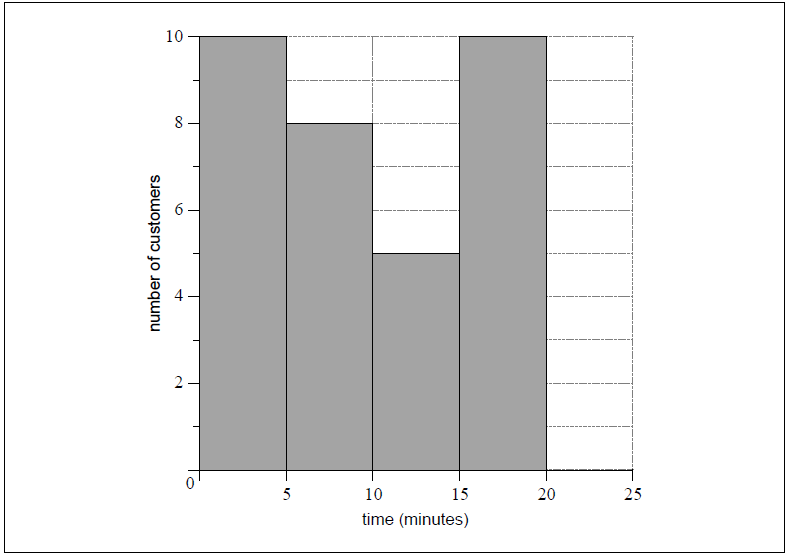
The mean time it took all customers to eat their lunch was estimated to be 12 minutes.
It was found that k customers took between 20 and 25 minutes to eat their lunch.
Write down the mid-interval value for 10 ≤ t < 15.[1]
Write down the total number of customers in terms of k.[1]
Calculate the value of k.[3]
Hence, complete the histogram.[1]
Answer/Explanation
Markscheme
12.5 (A1) (C1)[1 mark]
33 + k OR 10 + 8 + 5 + 10 + k (A1)
Note: Award (A1) for “number of customers = 33 + k”.[1 mark]
\(\frac{{2.5 \times 10 + 7.5 \times 8 + \ldots + 22.5 \times k}}{{33 + k}} = 12\) (M1)(A1)(ft)
Note: Award (M1) for substitution into the mean formula and equating to 12, (A1)(ft) for their correct substitutions.
(k =) 7 (A1)(ft) (C4)
Note: Follow through from part (b)(i) and their mid-interval values, consistent with part (a). Do not award final (A1) if answer is not an integer.[3 marks]
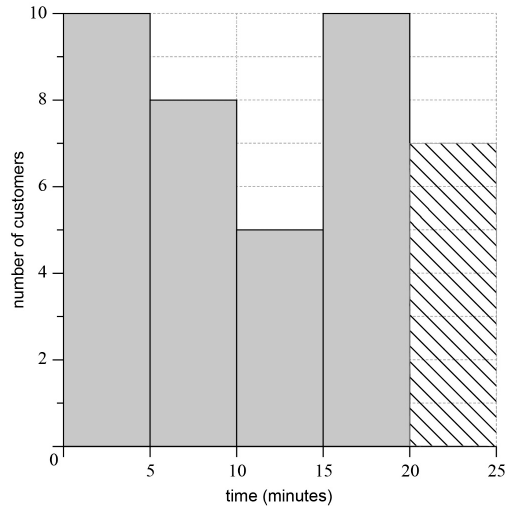 (A1)(ft) (C1)
(A1)(ft) (C1)
Note: Follow through from their part (b)(ii) but only if the value is between 1 and 10, inclusive.[1 mark]
Question
Consider the following set of data which is plotted on the scatter diagram below.

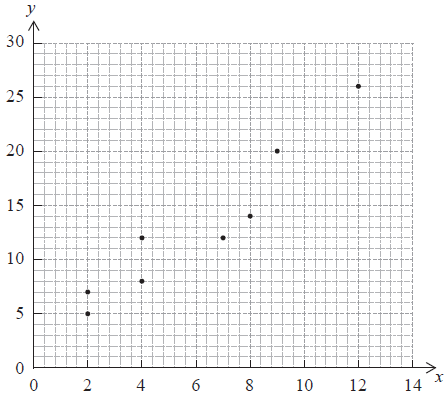
Write down the coordinates of the mean point \((\bar x{\text{, }}\bar y)\).[2]
Write down the value of \(r\), the Pearson’s product-moment correlation coefficient for this set of data.[2]
Draw the regression line for \(y\) on \(x\) on the set of axes above.[2]
Answer/Explanation
Markscheme
\((6{\text{, }}13)\) (A1)(A1) (C2)
\(0.952\) (\(0.95202 \ldots \)) (A2) (C2)
Note: Award (A0) for \(0.9\).
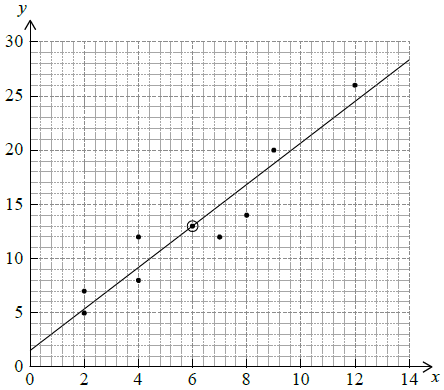
(A1) \(y\) intercept at \(y = 1.8\) (accept between 1 and 2)
(A1)(ft) line passes through their mean point (A1)(A1)(ft) (C2)
